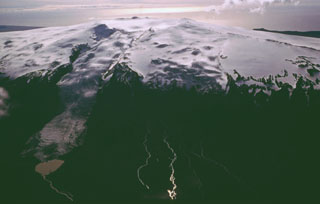Report on Eyjafjallajokull (Iceland) — 24 March-30 March 2010
Smithsonian Institution / US Geological Survey
Weekly Volcanic Activity Report, 24 March-30 March 2010
Managing Editor: Sally Sennert.
Please cite this report as:
Global Volcanism Program, 2010. Report on Eyjafjallajokull (Iceland) (Sennert, S, ed.). Weekly Volcanic Activity Report, 24 March-30 March 2010. Smithsonian Institution and US Geological Survey.
Eyjafjallajokull
Iceland
63.633°N, 19.633°W; summit elev. 1651 m
All times are local (unless otherwise noted)
According to news articles, the fissure eruption from Eyjafjöll continued during 24-30 March. On 24 March, steam explosions were seen. A local scientist described four or five active craters and a 200-meter-high basalt lava-fall into Hrunagil canyon. Two days later reports indicated that lava flows had changed course and had entered the Hvannárgil canyon down a 100-meter-high lava-fall; water levels in that drainage increased. From a helicopter on 28 March, scientists saw lava flowing into both canyons and noted fewer jets of lava. The next evening a swarm of earthquakes in the region measuring M 2-2.5 were detected. A geophysicist noted that seismicity was gradually decreasing. The lava covered an area of 1 square kilometer.
Geological Summary. Eyjafjallajökull (also known as Eyjafjöll) is located west of Katla volcano. It consists of an elongated ice-covered stratovolcano with a 2.5-km-wide summit caldera. Fissure-fed lava flows occur on both the E and W flanks, but are more prominent on the western side. Although the volcano has erupted during historical time, it has been less active than other volcanoes of Iceland's eastern volcanic zone, and relatively few Holocene lava flows are known. An intrusion beneath the S flank from July-December 1999 was accompanied by increased seismic activity. The last historical activity prior to an eruption in 2010 produced intermediate-to-silicic tephra from the central caldera during December 1821 to January 1823.
Sources: Iceland Review, Iceland Review, Iceland Review, Iceland Review

